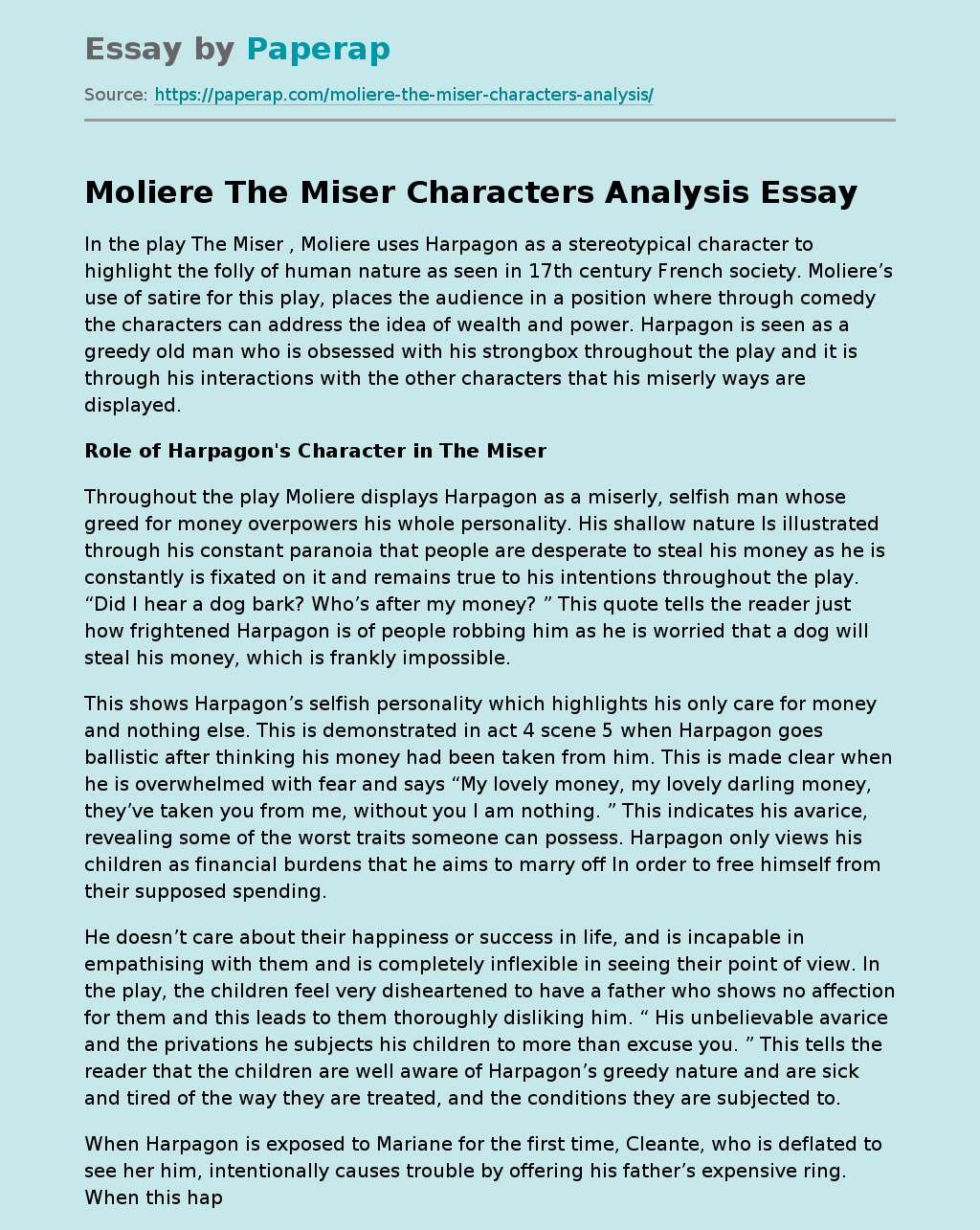In the play The Miser , Moliere uses Harpagon as a stereotypical character to highlight the folly of human nature as seen in 17th century French society. Moliere’s use of satire for this play, places the audience in a position where through comedy the characters can address the idea of wealth and power. Harpagon is seen as a greedy old man who is obsessed with his strongbox throughout the play and it is through his interactions with the other characters that his miserly ways are displayed.
Role of Harpagon’s Character in The Miser
Throughout the play Moliere displays Harpagon as a miserly, selfish man whose greed for money overpowers his whole personality. His shallow nature Is illustrated through his constant paranoia that people are desperate to steal his money as he is constantly is fixated on it and remains true to his intentions throughout the play. “Did I hear a dog bark? Who’s after my money? ” This quote tells the reader just how frightened Harpagon is of people robbing him as he is worried that a dog will steal his money, which is frankly impossible.
This shows Harpagon’s selfish personality which highlights his only care for money and nothing else. This is demonstrated in act 4 scene 5 when Harpagon goes ballistic after thinking his money had been taken from him. This is made clear when he is overwhelmed with fear and says “My lovely money, my lovely darling money, they’ve taken you from me, without you I am nothing.
” This indicates his avarice, revealing some of the worst traits someone can possess. Harpagon only views his children as financial burdens that he aims to marry off In order to free himself from their supposed spending.
He doesn’t care about their happiness or success in life, and is incapable in empathising with them and is completely inflexible in seeing their point of view. In the play, the children feel very disheartened to have a father who shows no affection for them and this leads to them thoroughly disliking him. “ His unbelievable avarice and the privations he subjects his children to more than excuse you. ” This tells the reader that the children are well aware of Harpagon’s greedy nature and are sick and tired of the way they are treated, and the conditions they are subjected to.
When Harpagon is exposed to Mariane for the first time, Cleante, who is deflated to see her him, intentionally causes trouble by offering his father’s expensive ring. When this happens as predicted, Harpagon is filled with rage and says “Abomination of a son! ” This further indicates how unaffectionate Harpagon is towards his children and how he cares much more about his wealth than his son or possible future wife. Harpagon views marriage as simply a contract between two people, rather than the notion of love and compatibility. In the play Harpagon views marriage on how he can benefit from it rather than his children life-long happiness.
This is displayed when he urges Elise to marry Anselme, due to the fact that there is no dowry, rather than bearing Elise’s feelings in mind. Marriage to him, is simply a way to get his children off his hands so that he can continue his consistent goal to maintain his wealth. This is shown when Elise says “ No father sacrifices his daughter like this. ” This emphasises how Harpagon differs from the other parents who have their children’s best interests at heart. Moliere uses Harpagon to illustrate a man constantly paranoid of servants stealing his money and believes that money should only be spent on the bare essentials.
In act 1 scene 3, Harpagon’s obsessive paranoia of money is shown for the first time when he abuses one of his servants for a thievery they most certainly did not commit. This is highlighted when Harpagon neurotically searches La Fleche’s pants and pockets to see if he had stolen anything. He feels as though everyone around him is striving for wealth as much as he is and fears that others will try and take it from him. In the play Harpagon’s paranoia proves very dislikeable and frustrating to his servants when La Fleche says” People like him should be hoist from their own petard.
I’d really enjoy thieving from him. ” Not only paranoid Moliere indicates Harpagon to be very outrageous when managing household finances as well. In act 3 scene 1 when preparing for Mariane’s arrival, Harpagon’s avarice is further illustrated when Valere says “We must eat to live, not live to eat. ” Harpagon then says with pride “That’s the most beautiful thing I’ve ever heard. ” This tells the reader that Harpagon only believes in the bare essentials of food rather than a substantial, enjoyable meal, hence he would not spend any extra money that he believes he shouldn’t.
This shows Harpagon’s selfish nature and his greed. Throughout this play, Moliere explores the worst character traits and brings them together to create a comedy, built by the satire that is Harpagon. Through consistent scenes demonstrating his greed and avarice, the reader is able to establish the storyline as Harpagon’s strive for fortune and power, and him being the only character who remains true to their worst intentions even at the end of the play.
Moliere The Miser Characters Analysis. (2019, Dec 05). Retrieved from https://paperap.com/moliere-the-miser-characters-analysis/

